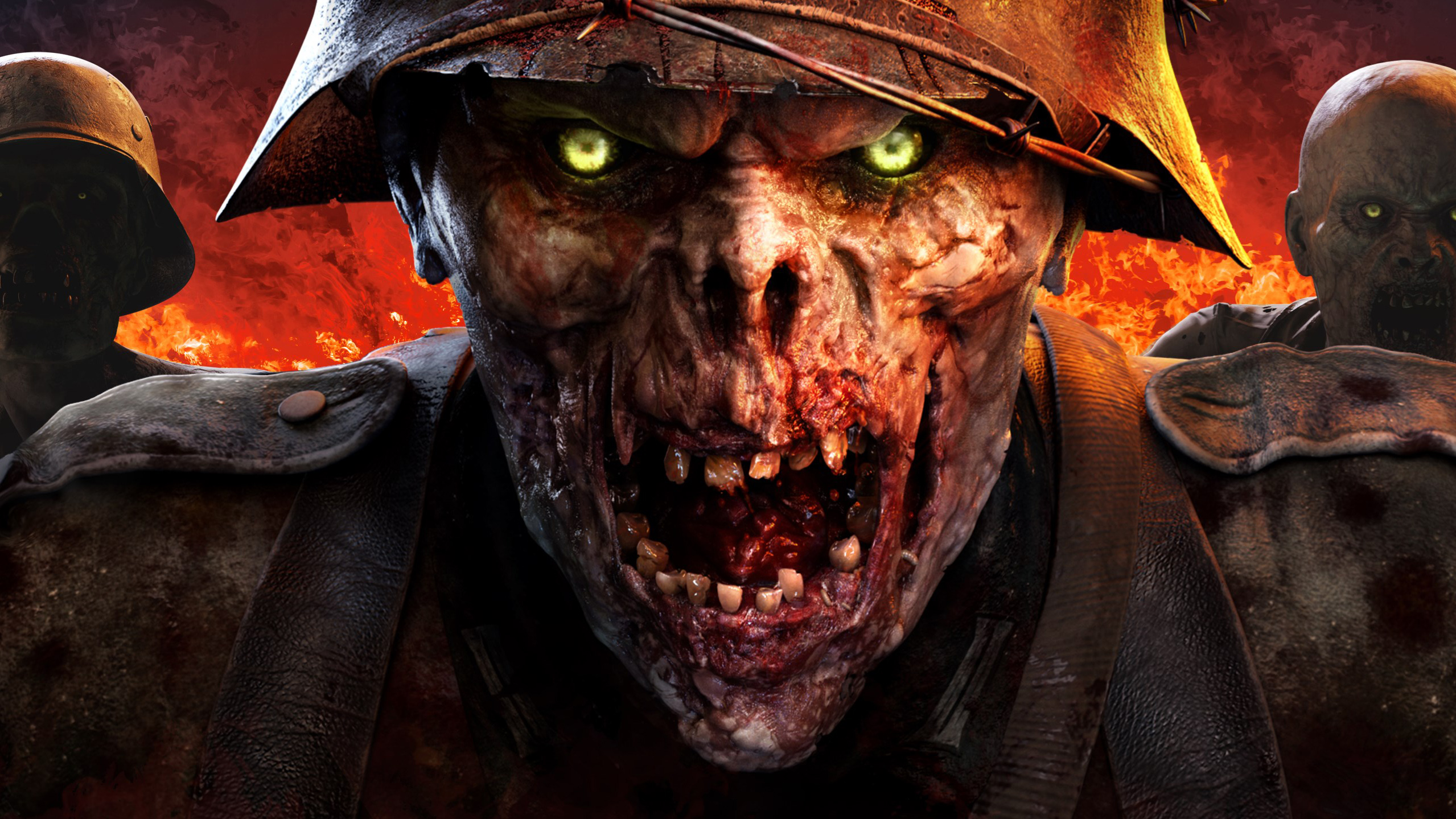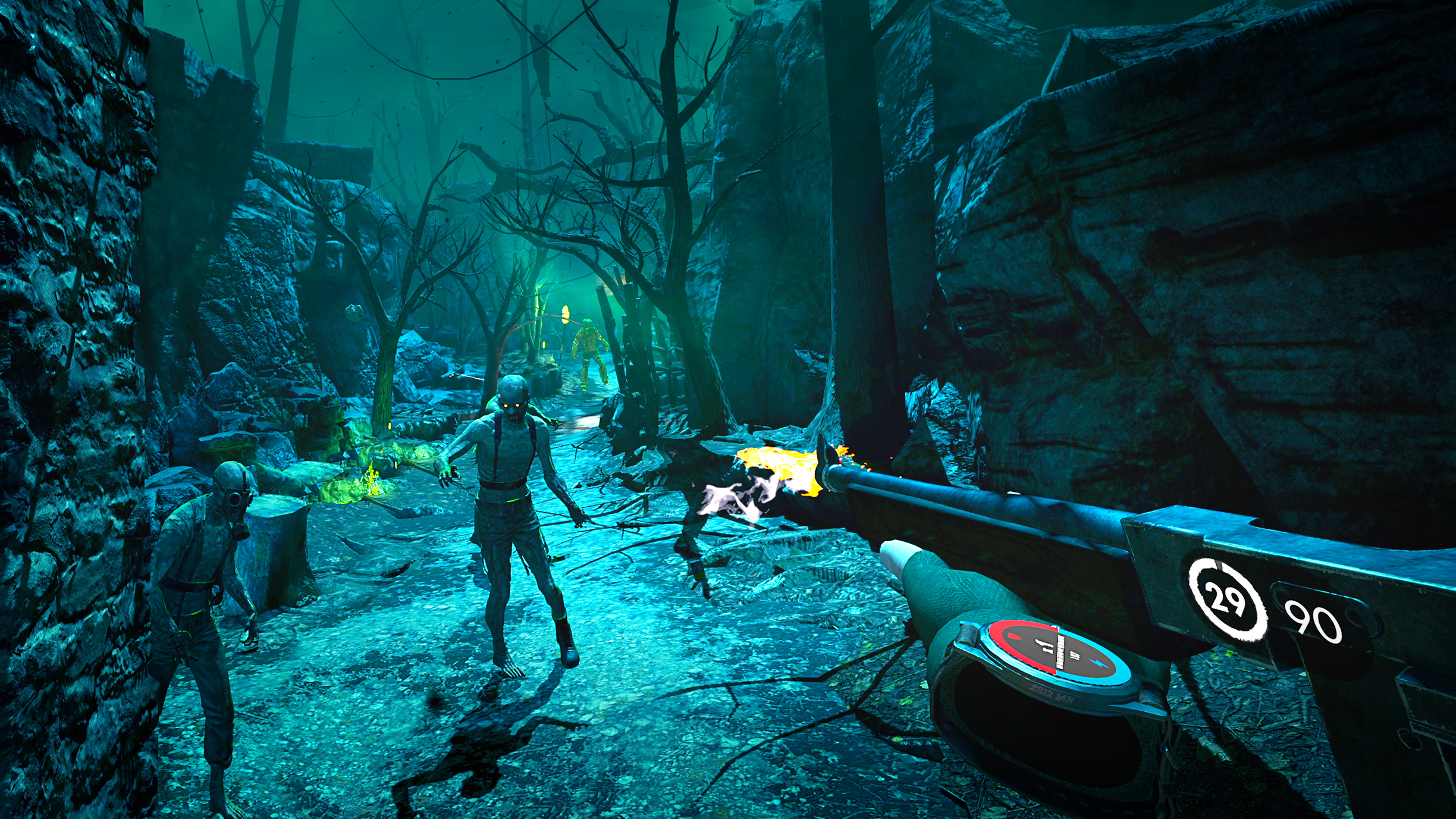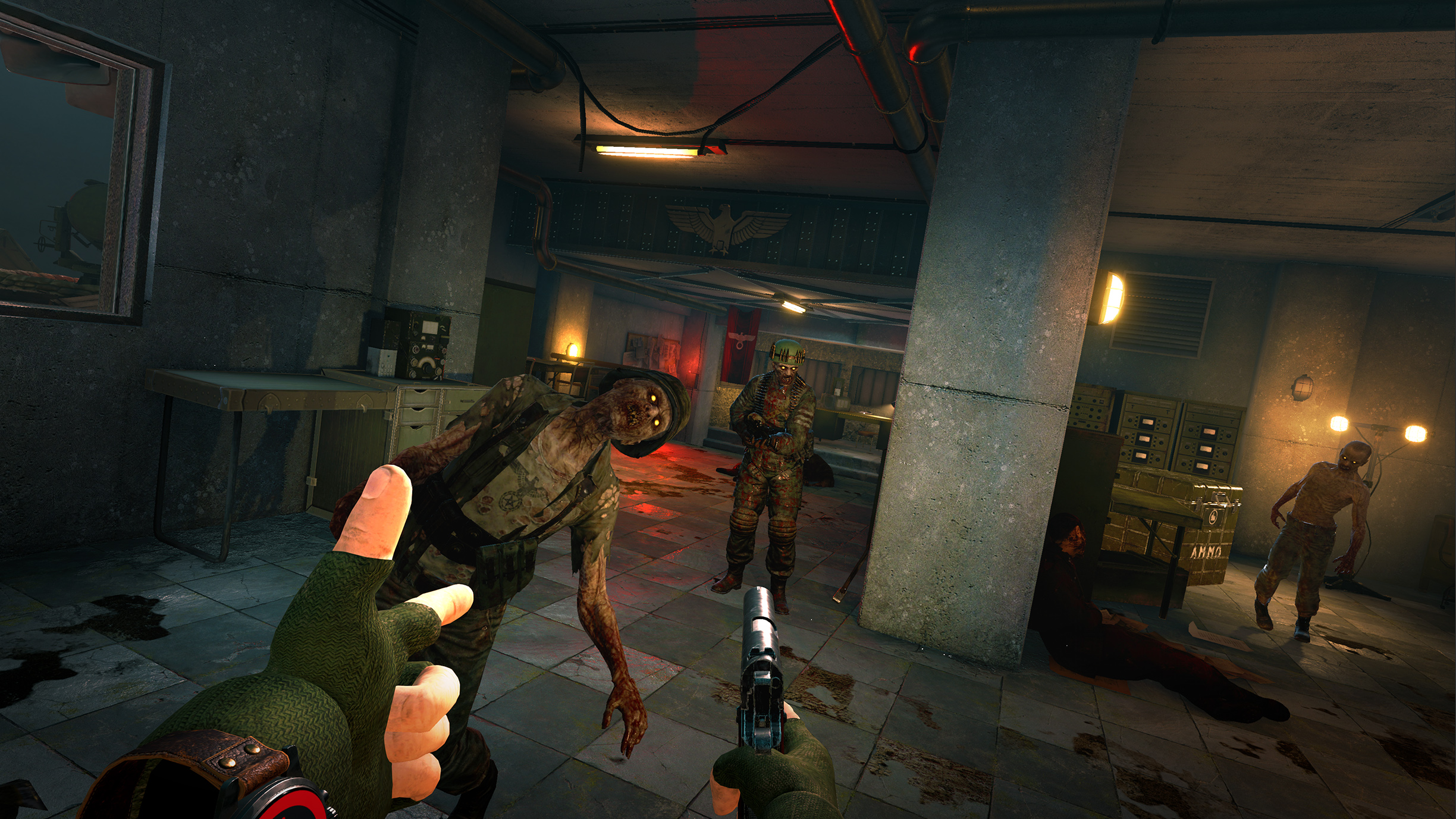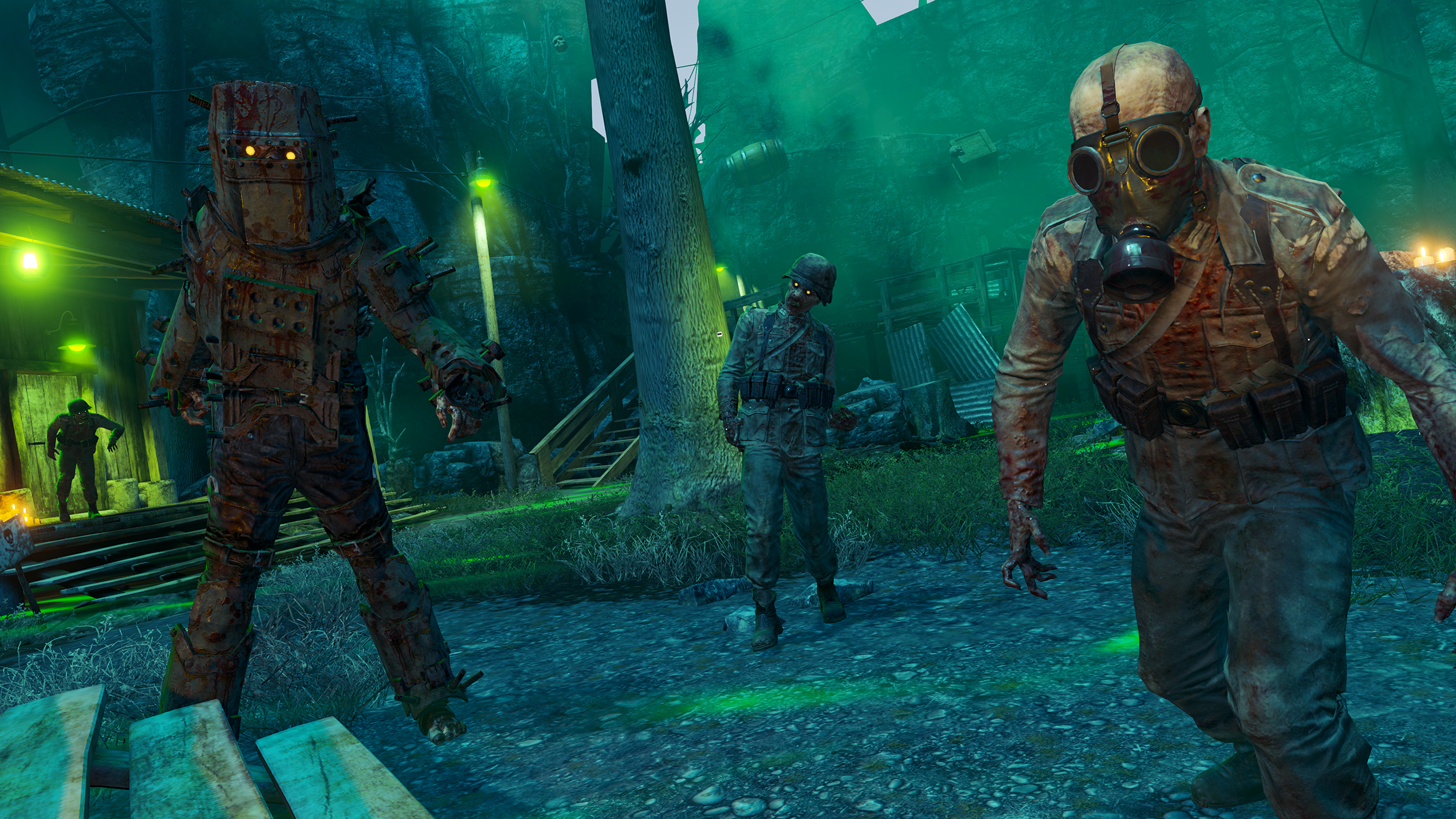
While the love for Apple Vision Pro has cooled and Sony is showing signs of dampening expectations on its own headset, PlayStation VR2, virtual reality remains a creative and accessible way for artists to break into the games industry.
One game that's caught my eye is Zombie Army VR, a virtual reality edition of Rebellion's World War 2 comic-book-inspired shooter that looks like House of the Dead in virtual reality. The last game in the series, Zombie Army 4: Dead War, released onto the best game consoles four years ago, but remains a fun and fraught horror shooter for anyone who misses the retro gaming days of Sega's lightgun shooter.
Coming to all the best VR headsets, including PlayStation VR2, Meta Quest 2, 3 and Pro, Oculus Rift, and PC headsets via Steam, Zombie Army VR promises to be a unique and frantic virtual reality experience.

Speaking with the game's head of art, Richard Turner, who describes Zombie Army VR's art style as a "dark and bloody WW2 horror, with a cool comic book wrapper", and I can't help but feel the urge to dust off my poorly ignored PSVR2.
"The game draws you into this moody familiar reality with tonnes of undead Nazi soldiers to dispatch before then throwing you out of your comfort zone. This transports you to an alternate world where reality is fractured and even gravity is not as expected," describes the art director, adding: "The shooting experience is really at the heart of Zombie Army VR, and the art style is really focused on making that a super responsive and visually rewarding experience. All the gunplay, muzzle flashes, bullets, impact effects, and explosions are designed to feel visually punchy and satisfying to players."

Achieving Zombie Army VR's mix of comic-book visual design, arcade game design and VR interaction has meant structuring the team so artists and game designers collaborate.
"Within the art team I try to promote the philosophy that improving our knowledge of good game design mechanics makes us better artists by default," explains Rebellion's head of art, Richard Turner. "Art is present to communicate great design, we provide the visual wrapper to the immersive VR experience that the design team is creating."
Get the Creative Bloq Newsletter
Daily design news, reviews, how-tos and more, as picked by the editors.
He continues: "Where possible, we create feature teams that comprise all disciplines, which has the benefit of keeping a core skill set focused on a feature to iterate on quality. This also has the added side effect of improving everyone’s knowledge of the cross-discipline effort that goes into game development."
Below you can read my full interview with Richard, where he discusses the challenges of creating art for VR, what players can expect from Zombie Army VR, including its two-handed rifle simulation and manual reloading under pressure, and how he envisions the future of virtual reality.

Can you elaborate on how the art direction collaborated with other departments to create a cohesive and immersive atmosphere in Zombie Army VR?
Within the art team I try to promote the philosophy that improving our knowledge of good game design mechanics makes us better artists by default. Art is present to communicate great design, we provide the visual wrapper to the immersive VR experience that the design team is creating.
Where possible, we create feature teams that comprise all disciplines, which has the benefit of keeping a core skill set focused on a feature to iterate on quality. This also has the added side effect of improving everyone’s knowledge of the cross-discipline effort that goes into game development.
Can you share insights into the process of creating the visuals for the VR environments, does immersion change how you design?
VR development means environment artists approach their asset creation pipelines differently from console and PC titles. The challenge is that VR players can get up close and personal with many objects in the game. They can pick things up and scrutinise them and compare them to objects in reality, so if a cup or desk lamp is low visual quality then it can break immersion.
The flip side is we can’t just increase the fidelity of all objects as we would create performance issues on the current generation of hardware.
Another VR-specific consideration is you can’t guarantee that a player is looking or traversing a space as you intended them to. People behave differently in VR than they might do in a first person console game, so the team deploys a variety of art layers to ensure the visual gameplay language is consistent and intuitive, like designing a focused lighting pass or other visual sign-posting to guide players onwards.
Has designing for VR become easier, or does new headset tech bring new challenges?
From an art perspective, the challenge when developing in VR is down to balancing any performance restrictions against the quality of the immersion. This is largely because VR headsets are less powerful than PCs or consoles. But, VR technology improves with every new hardware release, so this latest generation certainly gave us more opportunity to enhance the fidelity of the artwork in Zombie Army VR, and we’re excited to see where VR technology goes in the future.
Are there any shocks in store for zombie fans?
Zombie Army VR has some great moments. But, none in my mind draw close to the emotional reaction of being there in the room as zombies emerge from a grave, crawl out of a duct, or fall from a platform into your path. It’s the blind panic you feel fumbling with your weapon magazine, reloading your gun, and trying to shoot the next zombie in the head before it reaches you. It feels like you have been transported directly into a Zombie movie and the moment-to-moment gunplay is king, which in my mind tops any one single spectacle or set piece.
What kind of VR interaction can players expect?
This isn’t an RPG or adventure game and player interactions with the objects are intentionally light. Instead, we have focused on the pure satisfaction of interacting with some amazing high-quality, realistic weapons and blasting body parts off zombies. The player can discover a variety of unexpected tools scattered around the levels too; you can pick up a crowbar or hammer and knock seven bells out of those undead meat stacks if you choose!
What did the studio learn from previous VR games, like Sniper Elite VR?
Weapon quality and handling has taken a big step forward for ZAVR, it is truly great. The style of the game also means that the feel of the weapons is less simulation focussed when compared to Sniper Elite VR. The weapons are much higher quality assets in Zombie Army VR and more satisfying to fire in the game.
Also, the team has developed many new technical approaches to manage performance and get the best out of this generation of VR headsets. We have designated lighting artists helping with the game too, so I am confident you will see a big leap in quality when you compare ZAVR to SEVR.
Were there any unusual or particularly VR-focussed challenges you overcame?
Perhaps our main challenges surround immersion and believability. You always have to consider that the player can look anywhere and at anything far closer than they would in a non-VR game. The solution was to ensure that the highest quality assets are closest to eye level and model complexity radiates out from there. This enables us to reduce the expense of props and levels further from the player’s eye.
How do you foresee the evolution of art direction in VR?
I am in love with the VR medium and I think technology is the key to answering this question. We are getting closer and closer to lightweight, powerful VR units that we can comfortably wear for the same session lengths as consoles without fatigue or motion sickness. Improving these aspects of technology will open the door to some wonderful VR experiences without compromise… we are talking about being front seat at a Chicago Bulls game, a character in an Avatar film, or a viable laptop replacement.
In relation to Zombie Army, just imagine a super powerful VR headset that scans my house in seconds and uses clever design algorithms to turn my house into a zombie apocalypse shoot-fest.
This could see the undead breaking through my own windows and trying to eat my brains. As a horror fan, this seamless blur of reality and game could be the holy grail experience we have been looking for… just don’t fall asleep with the headset on and wake up as zombie breakfast!
If you're keen to know more about how VR games are made, read my interview with art director Alina Fedaseyenka about making the award-winning shooter Synapse. It's also worth reading my reviews of PSVR 2 horror shooters Arizona Sunshine 2 and The Dark Pictures: Switchback VR to discover two great games for VR headsets.

Thank you for reading 5 articles this month* Join now for unlimited access
Enjoy your first month for just £1 / $1 / €1
*Read 5 free articles per month without a subscription

Join now for unlimited access
Try first month for just £1 / $1 / €1

Ian Dean is Editor, Digital Arts & 3D at Creative Bloq, and the former editor of many leading magazines. These titles included ImagineFX, 3D World and video game titles Play and Official PlayStation Magazine. Ian launched Xbox magazine X360 and edited PlayStation World. For Creative Bloq, Ian combines his experiences to bring the latest news on digital art, VFX and video games and tech, and in his spare time he doodles in Procreate, ArtRage, and Rebelle while finding time to play Xbox and PS5.
